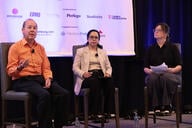You have /5 articles left.
Sign up for a free account or log in.
Over the last few years, we’ve heard much discussion about the disenfranchisement of the working class and our nation’s failure to educate them. The lack of skilled workers is starting to have widespread repercussions: according to a recent survey by Manpower, 46 percent of U.S. employers are struggling to fill job vacancies. And for the seventh consecutive year, employers report that skilled trade vacancies are the hardest to fill. At the same time, many people in the middle class are finding it hard to afford the cost of higher education, leaving behind more and more people who wish to earn a degree but cannot handle the financial burden.
Fortunately, a spirit of reform is in the air when it comes to higher education in general and vocational education in particular. Lawmakers and higher education professionals are looking for ways to address declining enrollment numbers and skyrocketing tuition, as well as to repair the knowledge gap in today’s work force.
For example, in spring of 2018, a group of university system presidents, chancellors, journalists and others working in higher education gathered at Utah Valley University to discuss alternative models to the traditional four-year institution, which many believe, while still enormously relevant, needs to explore new pathways for students.
Articulation agreements, dual admissions and co-located degrees are some of the methods higher education has been exploring lately. In Utah, three universities -- including Utah Valley, where I previously served as president -- use a “dual-mission” model of higher education. That model combines under one roof the advanced training of a teaching university with the openness and vocational programs of a community college. All three institutions began as vocational schools and gradually expanded into universities while retaining their community college and open-admissions roots. Weber State University pioneered this approach in 1991. UVU followed suit in 2008 and is now the largest public university in the state, with an enrollment of nearly 40,000 students.
Similar models have been cropping up across the country. One manifestation is merging universities with community colleges. Georgia, for example, has been combining some of its universities and community colleges, and Wisconsin began doing the same this fall. Both states saw the need to consolidate in that way when enrollment at rural community colleges started dropping as the population in those areas shrank.
Other states are developing dual-mission institutions through expansion rather than consolidation. Community colleges across the country have added select bachelor degrees to their programs to answer local industry needs, as well as to provide an easier path for students to obtain a higher degree. Florida was one of the first to begin taking this approach.
Some two-year-degree institutions are establishing formal collaborations with four-year ones. Pulaski Technical College, a technical school in north Little Rock, Ark., that offers classes in construction, collision repair, nursing and other subjects, has struggled with low graduation rates. Recently, it partnered with the University of Arkansas Little Rock to give students better opportunities by allowing them to more seamlessly transition to a baccalaureate program after obtaining a two-year degree. Graduation rates are improving, said Pulaski chancellor Margaret Ellibee, a hopeful sign for the region.
Many of these models can help universities save costs and keep tuition low by sharing staff, faculty members and infrastructure. Meanwhile, the dual-mission model -- or “dual function,” as Georgia calls it -- gives students who start on a vocational or community college track the certificate or two-year degree they desire, while also allowing them to continue toward an advanced degree much more smoothly and efficiently than if they were to transfer to a different institution.
This model can also help two-year colleges in rural areas keep young people in their communities by giving them options beyond an associate degree that don’t require moving to an urban area. As many of those rural colleges have found, when two-year graduates transfer to a larger university in a more metropolitan area, they are less likely to come back and build a life in the community. That has been the case with Red Deer College in Alberta, Canada, where many of its graduates moved on to obtain degrees in bigger cities like Calgary and Edmonton and didn’t return. As a result, the college recently received approval to begin adding four-year degrees to its program, while retaining its mandate to provide vocational training and two-year degrees.
At the heart of all of these models is the idea that more options in higher education should be available to more people. At the recent gathering on dual-mission institutions, Raymond Cross, president of the University of Wisconsin System, said that one reason that the system’s 13 community colleges are merging with seven of its four-year universities is that the state needs to retain access and expand opportunity -- particularly as the population in its rural areas declines. “If we leave these communities, they’ll fold up and be gone,” he warned.
Steve Wrigley, chancellor of the University System of Georgia, said that since his state began combining some of its community colleges and universities, students have gotten access to more degrees and are being served better. One college once offered only four bachelor degrees, he said. After the consolidation, that institution now provides 22.
The dual-mission model is not for every institution, and it is not without its challenges. At Utah Valley, following a strategic set of guidelines has helped make the model work. To begin with, the university has asked faculty members to focus on teaching. It has also encouraged them to involve undergraduates as much as possible in any applied and practical research work they conduct. As a result, professors -- many of whom teach at both the certificate/two-year level and the four-year level -- are more engaged with the students, providing an educational experience that has driven the institution’s growth. It has also kept costs down and tuition low, so that the university is accessible to as many people as possible.
Utah Valley has also succeeded by sharing resources; focusing on affordable sports programs (such as Division I soccer instead of an expensive football team); maintaining a highly transparent budgeting process that helps keep it accountable to faculty members, administrators and students, as well as the state; and building programs based as much on civic input and economic data as on student interest and faculty expertise. For example, when considering new degrees and programs, we often consider the needs of local industry and what jobs are needed in the region.
In addition, the university instituted a structured enrollment process. Under such a system, trained staff members guide newly admitted students who do not meet college-ready standards -- a certain grade point average and entrance test score -- toward a two-year associate degree or a certificate program, after which those students, when qualified, can progress to the university. Such students effectively transfer their credits into four-year degree programs without loss of any credit -- and with no additional costs. The success of this model is a big part of the reason why the university’s biggest growth rate now comes in its junior and senior classes.
While the dual-mission model is far from a universal solution to the problems of higher education today, many communities and institutions could find it useful in controlling costs, increasing enrollment and expanding accessibility. One key here is getting leadership and stakeholders together regularly to explore and share best practices. That can help institutions that are already pursuing a dual mission better navigate the challenges involved with such an approach, as well as increase awareness among other colleges and universities that might benefit from the approach but not even understand it is a viable option. It will also contribute to what many higher education observers have been requesting for years: that we start to place more value than we have in the past on approaches other than the model of the elite research institution.
As tremendous as those expensive, hard-to-get-into, research-intensive institutions are -- and we do need them -- we cannot accept that they are the only path to strong educational and cultural respectability. Higher education must provide better, more affordable opportunities for more people. In Utah, we have pioneered a dual-mission system that is achieving just that.
But the benefits go beyond even cost and quality preparation options for life and career. Incorporating a community college operation within a university environment also gives less academically oriented students a greater sense of worldliness and self-assurance, while building practical skills and career readiness for those on an academic four-year path. At the same time, it fosters robust social and academic interaction between both groups. As the nation and the world see more and more polarization between elites and the working class, the significance of this intangible benefit is hard to overstate.
Traditional approaches that strictly separate the functions of a community college and university still have their place. But the evidence already shows that those models alone are insufficient for our times. The growing movement of colleges and universities exploring new and blended models of higher education is a most encouraging sign.




